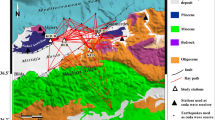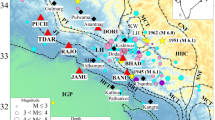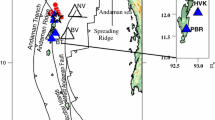Abstract
About eighty earthquakes, exclusively from the Hindukush region, which were recorded at Gauribidanur seismic array (GBA) have been used in the present study. Short periodP-wave recordings upto 36 seconds were processed using adaptive cross-correlation filtering technique. The main objective of this exercise was to examine the signal complexities and seismic ray direction anomalies of these earthquakes which have identical epicentral distances and a narrow azimuthal range from GBA but different focal depths from 10 to 240 km. Slowness anomalies of the order of 1–4 sec/deg and azimuthal anomalies upto 6° have been found in this case. These deviations have been attributed to the upper mantle region between source and the receiver. Analysis of the data reveals that most of the events occurring at shallower depths had complex signatures as compared to the deeper events. The structure near the source region, complicated source functions and scattering confined to the crust-upper mantle near source are mainly responsible for complexity of the observed signals as the transmission path of the ray tubes from turning point to the recording stations is practically the same.
Similar content being viewed by others
References
Arora S K, Varghese T G and Krishnan C A 1970Nature (London) 225 261
Berteussen K A, Husebye E S, Mereu R F and Ram A 1977Earth Planet. Sci. Lett. 37 326
Brown R J 1973Pure Appl. Geophys. 109 1623
Capon J 1973 Semi Ann. Tech. Summary 30 June 1973, Seismic Discrimination Lincoln Laboratory, MIT
Carpenter E W 1964 Vesiac State of the Art Report 4410-67-x, University of Michigan (USA)
Chatelain J L, Roecker S, Hatzfeld D and Molnar P 1979EOS Trans. AGU 60 593
Corbishley D J 1970bGeophys. J. R. Astron. Soc. 21 415
Davies D and Sheppard R M 1972Nature (London) 239 318
Douglas A, Marshall P D, Gibbs P G, Yound J B and Blamey C 1973Geophys. J. R. Astron. Soc. 33 195
Engdahl E R 1974EOS Transactions. AGU 56 1147
Mereu R F and Ram A 1975 inExptoitation of seismograph networks (ed.) K G Beauchamp (NATO Adv. Study Inst. Series) p. 327
Niazi M 1956Bull. Seism. Soc. Am. 56 491
Noponen I 1974Bull. Seism. Soc. Am. 64 1931
Nowroozi A A 1972Bull. Seism. Soc. Am. 62 823
Ram A 1976The identification and interpretation of upper mantle travel time branches from slowness measurements made on data recorded at the Gauribidanur (India) and Yellow knife (Canada) seismic arrays Ph. D. Thesis (University of Western Ontario, London, Canada)
Ram A and Mereu R F 1977Geophys. J. R. Astron. Soc. 49 87
Ram A and Yadav L 1981Geophys. J. R. Astron. Soc. (in press)
Thirlaway H I S 1963New Sci. 18 311
Author information
Authors and Affiliations
Rights and permissions
About this article
Cite this article
Ram, A. Complex seismic signatures and narrow azimuthal study of Hindukush earthquakes. Proc. Indian Acad. Sci. (Earth Planet Sci.) 90, 189–195 (1981). https://doi.org/10.1007/BF02880263
Received:
Revised:
Issue Date:
DOI: https://doi.org/10.1007/BF02880263




